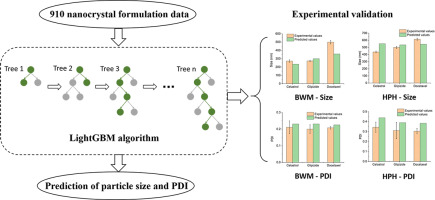当前位置:
X-MOL 学术
›
J. Control. Release
›
论文详情
Our official English website, www.x-mol.net, welcomes your
feedback! (Note: you will need to create a separate account there.)
Can machine learning predict drug nanocrystals?
Journal of Controlled Release ( IF 10.5 ) Pub Date : 2020-03-29 , DOI: 10.1016/j.jconrel.2020.03.043 Yuan He 1 , Zhuyifan Ye 1 , Xinyang Liu 1 , Zhengjie Wei 1 , Fen Qiu 1 , Hai-Feng Li 2 , Ying Zheng 1 , Defang Ouyang 1
Journal of Controlled Release ( IF 10.5 ) Pub Date : 2020-03-29 , DOI: 10.1016/j.jconrel.2020.03.043 Yuan He 1 , Zhuyifan Ye 1 , Xinyang Liu 1 , Zhengjie Wei 1 , Fen Qiu 1 , Hai-Feng Li 2 , Ying Zheng 1 , Defang Ouyang 1
Affiliation

|
Nanocrystals have exhibited great advantage for enhancing the dissolution rate of water insoluble drugs due to the reduced size to nanoscale. However, current pharmaceutical approaches for nanocrystals formulation development highly depend on the expert experience and trial-and-error attempts which remain time and resource consuming. In this research, we utilized machine learning techniques to predict the particle size and polydispersity index (PDI) of nanocrystals. Firstly, 910 nanocrystal size data and 341 PDI data by three preparation methods (ball wet milling (BWM) method, high-pressure homogenization (HPH) method and antisolvent precipitation (ASP) method) were collected for the construction of the prediction models. The results demonstrated that light gradient boosting machine (LightGBM) exhibited well performance for the nanocrystals size and PDI prediction with BWM and HPH methods, but relatively poor predictions for ASP method. The possible reasons for the poor prediction refer to low quality of data because of the poor reproducibility and instability of nanocrystals by ASP method, which also confirm that current commercialized products were mainly manufactured by BWM and HPH approaches. Notably, the contribution of the influence factors was ranked by the LightGBM, which demonstrated that milling time, cycle index and concentration of stabilizer are crucial factors for nanocrystals prepared by BWM, HPH and ASP, respectively. Furthermore, the model generalizations and prediction accuracies of LightGBM were confirmed experimentally by the newly prepared nanocrystals. In conclusion, the machine learning techniques can be successfully utilized for the predictions of nanocrystals prepared by BWM and HPH methods. Our research also reveals a new way for nanotechnology manufacture.
中文翻译:

机器学习能否预测药物纳米晶体?
由于减小了纳米级的尺寸,纳米晶体在提高水不溶性药物的溶解速率方面显示出极大的优势。然而,当前用于纳米晶体制剂开发的药物方法高度依赖于专家经验和反复试验的尝试,这仍然浪费时间和资源。在这项研究中,我们利用机器学习技术来预测纳米晶体的粒径和多分散指数(PDI)。首先,通过三种制备方法(球形湿磨(BWM)法,高压均质化(HPH)法和抗溶剂沉淀(ASP)法)收集了910个纳米晶体尺寸数据和341个PDI数据,以建立预测模型。结果表明,光梯度增强机(LightGBM)在BWM和HPH方法的纳米晶体尺寸和PDI预测中表现出良好的性能,但对ASP方法的预测却相对较差。预测不佳的可能原因是由于ASP方法导致纳米晶体的重现性和不稳定性,因此数据质量低下,这也证实了目前的商品化产品主要是通过BWM和HPH方法制造的。值得注意的是,影响因素的贡献由LightGBM排名,这表明研磨时间,循环指数和稳定剂的浓度分别是BWM,HPH和ASP制备的纳米晶体的关键因素。此外,新制备的纳米晶体通过实验证实了LightGBM的模型推广和预测精度。总之,机器学习技术可以成功地用于BWM和HPH方法制备的纳米晶体的预测。我们的研究还揭示了纳米技术制造的新方法。
更新日期:2020-03-30
中文翻译:

机器学习能否预测药物纳米晶体?
由于减小了纳米级的尺寸,纳米晶体在提高水不溶性药物的溶解速率方面显示出极大的优势。然而,当前用于纳米晶体制剂开发的药物方法高度依赖于专家经验和反复试验的尝试,这仍然浪费时间和资源。在这项研究中,我们利用机器学习技术来预测纳米晶体的粒径和多分散指数(PDI)。首先,通过三种制备方法(球形湿磨(BWM)法,高压均质化(HPH)法和抗溶剂沉淀(ASP)法)收集了910个纳米晶体尺寸数据和341个PDI数据,以建立预测模型。结果表明,光梯度增强机(LightGBM)在BWM和HPH方法的纳米晶体尺寸和PDI预测中表现出良好的性能,但对ASP方法的预测却相对较差。预测不佳的可能原因是由于ASP方法导致纳米晶体的重现性和不稳定性,因此数据质量低下,这也证实了目前的商品化产品主要是通过BWM和HPH方法制造的。值得注意的是,影响因素的贡献由LightGBM排名,这表明研磨时间,循环指数和稳定剂的浓度分别是BWM,HPH和ASP制备的纳米晶体的关键因素。此外,新制备的纳米晶体通过实验证实了LightGBM的模型推广和预测精度。总之,机器学习技术可以成功地用于BWM和HPH方法制备的纳米晶体的预测。我们的研究还揭示了纳米技术制造的新方法。











































 京公网安备 11010802027423号
京公网安备 11010802027423号